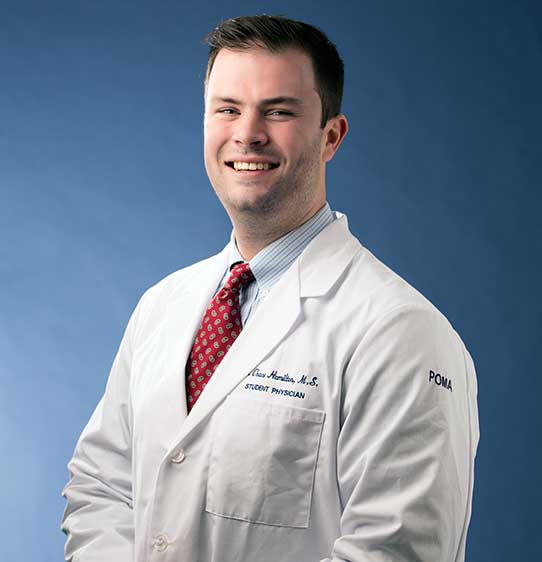Student Research Spotlight
Winston Hamilton (DO '20)
April 16, 2018
 Winston (“Chase”) Hamilton (DO ‘20) is interested in a career in anesthesiology; in
addition to his studies at PCOM, Mr. Hamilton worked as a research fellow in the Department
of Anesthesiology at Thomas Jefferson University. His research fellowship focused
on the testing of novel insulin formations designed to enhance the absorption of insulin
into the bloodstream. His mentors were Jeffrey I. Joseph, DO ’83, director of the
Jefferson Artificial Pancreas Center and Marc Torjman, PhD. Mr. Hamilton received
an MS from Drexel University College of Medicine and a BA from Johns Hopkins University.
Winston (“Chase”) Hamilton (DO ‘20) is interested in a career in anesthesiology; in
addition to his studies at PCOM, Mr. Hamilton worked as a research fellow in the Department
of Anesthesiology at Thomas Jefferson University. His research fellowship focused
on the testing of novel insulin formations designed to enhance the absorption of insulin
into the bloodstream. His mentors were Jeffrey I. Joseph, DO ’83, director of the
Jefferson Artificial Pancreas Center and Marc Torjman, PhD. Mr. Hamilton received
an MS from Drexel University College of Medicine and a BA from Johns Hopkins University.
What did you study?
We investigated whether adding other drugs to commercial insulin will enhance the
speed and consistency of insulin absorption below the skin surface. Theoretically,
this drug combination will cause less inflammation and scar tissue around the catheter
site than insulin alone, leading to faster and more consistent absorption of insulin
over time.
What prompted you to pursue research?
The summer after the first year of medical school is the last designated “summer”
of our lives and a unique time to–quite literally– do whatever you want. I knew I
wanted to spend that time involved in medical research in some capacity, specifically
as it related to anesthesia. I learned about the Foundation for Anesthesia Education
and Research’s (FAER) Medical Student Anesthesia Research Fellowship Program (MSARF)—which
funded my research fellowship—and it seemed like the perfect opportunity.
Research underlies and dictates the practice of medicine. No matter what specialty
I go into, I want to be active in the procurement of new medical knowledge that leads
to the advancement of patient care. I wanted to see what research was like from a
clinician’s perspective, as this is something I am interested in pursuing throughout
my medical career.
What experience do you have conducting research?
The FAER MSARF program consisted of eight weeks of focused research related to anesthesiology.
I was placed with a dedicated mentor—Dr. Joseph—who provided training in research
techniques and scientific methods. I began at the lab prior to the initiation of the
study, so I was able to participate in the work from beginning to its conclusion.
This was a great experience, as I got to see the progression of the study through
three rounds of experiments. I witnessed the amount of expertise required not only
to run a translational experiment but to prepare for it months in advance.
Dr. Joseph also emphasized the importance of attaining strong medical knowledge and
clinical skills in conducting sound research. He took the time to lecture us on topics
relating to the project and always found time for teaching-moments—even in the middle
of an experiment. In this way, my research experience was also a transformative educational
experience.
What were your responsibilities in your research project?
We compared a new insulin formulation designed to enhance the rate and consistency
of insulin absorption from the subcutaneous tissue into the bloodstream to a commercial
rapid-acting insulin routinely used by people with type 1 diabetes. Insulin infusion
catheters were inserted into the subcutaneous fatty tissue of the abdomen and connected
to an insulin pump. Insulin was continuously infused into the subcutaneous tissue
throughout each 8-day experiment in one catheter and a non-insulin formulation was
infused through a second catheter as a control.
Every other day, a solution of glucose was infused into an intravenous catheter and
the rate of infusion adjusted upward/downward to keep the blood glucose concentration
within a narrow range. The amount of IV glucose infused over time provided an objective
measurement of the glucose-lowering (pharmacodynamics) effect of the insulin.
We also sample blood every 5 minutes to measure the concentration of insulin in plasma
over time to calculate the pharmacokinetic profile—essentially, how a drug is metabolized
by the body. Each study subject was studied for 8 days using commercial insulin, new
insulin formulation at a low dose and new insulin formulation at a higher dose, to
compare the pharmacokinetic and pharmacodynamics, using each subject as their own
control.
I was intimately involved in all levels of the project, from set-up and break down
of each study, to the collection and analysis of samples, to the operation of various
devices necessary for running the study. In addition, I helped analyze micro-CT images
of a bolus of x-ray contrast agent and insulin infused into the subcutaneous tissue,
to determine the pattern of distribution, volume and surface area of insulin in contact
with healthy subcutaneous tissue.
What is the broader impact of your research?
Up to 40 percent of type 1 diabetics use insulin and a continuous subcutaneous insulin
infusion catheter (CSII) to regulate their blood glucose levels. Insulin pump therapy
has been shown to improve blood glucose control and lifestyle flexibility compared
to multiple-daily insulin injections. A pump allows the user to set a base insulin
rate and then enter a larger dosage of insulin with each meal.
However, this technique comes with several issues. If a catheter is used for more
than three days, it can cause inflammation and build-up of scar tissue, which can
inhibit the flow of insulin, causing varying degrees of insulin absorption. Inflammation
at the catheter site can also trigger an immune response, which can metabolize or
degrade the insulin. Further, some insulin infused into the subcutaneous tissue can
also leak back onto the skin surface, leading to hyperglycemia (high blood glucose
level) and diabetic keto-acidosis. Slow and variable absorption can also lead a mismatch
between the absorption of food after a meal and the glucose-lowering effect of insulin,
leading to hypoglycemia (low blood glucose level). Severe hypoglycemia can cause a
seizure, unconsciousness, cardiac arrhythmias and sudden death.
The research project in which I participated sought to evaluate whether the new insulin
formulation will decrease the formation of inflammatory tissue around the CSII tube,
increase local capillary blood flow and increase flow into local lymph vessels. The
goal is to make insulin absorption faster and more consistent from dose-to-dose and
increase the longevity of a functioning CSII catheter (from 2-3 days to 7 days). We
hope this research will lead to improved blood glucose control and reduce the personal
burden of insulin therapy, improving the quality of life for people with type 1 diabetes.
You May Also Like:
About Philadelphia College of Osteopathic Medicine
Established in 1899, Philadelphia College of Osteopathic Medicine (PCOM) has trained
thousands of highly competent, caring physicians, health practitioners and behavioral
scientists who practice a “whole person” approach to care—treating people, not just
symptoms. PCOM, a private, not-for-profit accredited institution of higher education,
operates three campuses (PCOM, PCOM Georgia and PCOM South Georgia) and offers doctoral degrees in clinical psychology, educational psychology, osteopathic
medicine, pharmacy, physical therapy, and school psychology. The college also offers
graduate degrees in applied behavior analysis, applied positive psychology, biomedical
sciences, forensic medicine, medical laboratory science, mental health counseling,
physician assistant studies, and school psychology. PCOM students learn the importance
of health promotion, research, education and service to the community. Through its
community-based Healthcare Centers, PCOM provides care to medically underserved populations.
For more information, visit pcom.edu or call 215-871-6100.
Contact Us
For general media inquiries, please contact the Office of Marketing and Communications
at 215-871-6300 or communications@pcom.edu. Visit our media relations page to view contact information for public relations personnel.
Connect with PCOM

 Winston (“Chase”) Hamilton (DO ‘20) is interested in a career in anesthesiology; in
addition to his studies at PCOM, Mr. Hamilton worked as a research fellow in the Department
of Anesthesiology at Thomas Jefferson University. His research fellowship focused
on the testing of novel insulin formations designed to enhance the absorption of insulin
into the bloodstream. His mentors were Jeffrey I. Joseph, DO ’83, director of the
Jefferson Artificial Pancreas Center and Marc Torjman, PhD. Mr. Hamilton received
an MS from Drexel University College of Medicine and a BA from Johns Hopkins University.
Winston (“Chase”) Hamilton (DO ‘20) is interested in a career in anesthesiology; in
addition to his studies at PCOM, Mr. Hamilton worked as a research fellow in the Department
of Anesthesiology at Thomas Jefferson University. His research fellowship focused
on the testing of novel insulin formations designed to enhance the absorption of insulin
into the bloodstream. His mentors were Jeffrey I. Joseph, DO ’83, director of the
Jefferson Artificial Pancreas Center and Marc Torjman, PhD. Mr. Hamilton received
an MS from Drexel University College of Medicine and a BA from Johns Hopkins University.